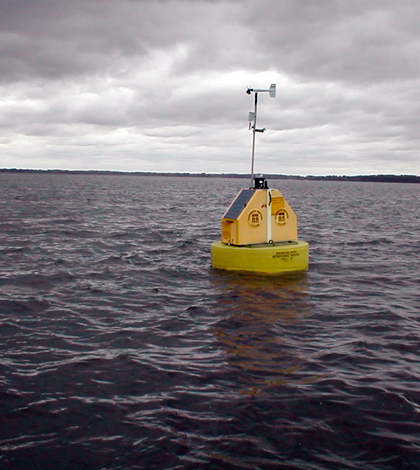Seneca Lake data buoy keeps watch on largest of the Finger Lakes

One of the Finger Lakes Institute's water quality data buoys (Credit: Finger Lakes Institute)
Cold Arctic air from the polar vortex spilled over parts of the U.S. last winter and froze 92 percent of the Great Lakes’ surface area — the most ice on those waters in 35 years. But even that record-setting cold couldn’t put a lid on Seneca Lake, that largest of the Finger Lakes.
“Because there’s such a huge volume and small surface area, it’s really hard to freeze these lakes unless things are really cold,” said John Halfman, professor of geolimnology and hydrogeochemistry at Hobart and William Smith Colleges. “Even last winter didn’t freeze Seneca Lake.”
Glaciers carved Seneca Lake’s deep, skinny bowl of to a depth of 618 feet, making it the deepest in New York and one of the deepest in the nation. A floating water quality platform probes those depths, supplying Halfman and other scientists with data to track the lake’s day-to-day functions and responses to water-clouding runoff.
Halfman has studied the Finger Lakes for the past two decades and leads a weekly monitoring program that began collecting data on the Seneca Lake and several tributaries in the 1990s. The data reveals trends that are moving in unhealthy directions, showing a lake growing more turbid. The causes are familiar: Runoff from rain events bring in suspended sediments and algae-fueling nutrients.

Professor John Halfman has studied the Finger lakes for around 20 years (Credit: Hobart & William Smith Colleges)
While those trends are made clear in the monitoring program’s simple measurements like Secchi disk readings, the weekly sampling trips can’t catch everything. That’s where the buoy comes in. Twice a day, a winch lowers an EXO2 multi-parameter sonde 55 meters through the water column. The sonde records seven dimensions of water quality every meter and a half.
Those data can capture things that the boat-based sampling program might overlook. For example, algae blooms are a concern on the lake, and the buoy’s chlorophyll and blue-green algae sensors will catch any blooms that only last for three or four days that happen to fall between sampling trips.
“A routine weekly monitoring program would miss some of the algal activity,” Halfman said. “If you have something sampling every day, you’ll detect it and note it in your studies.”

Provisional data from the Seneca Lake buoy collected Sept. 11-18, 2014. Click for larger version. (Credit: Finger Lakes Institute)
The buoy can also show off one of the features characteristic to a long skinny lake like Seneca and the other Finger Lakes: a large internal wave that can rock back and forth in the when wind conditions are right. When that wave, or seiche, is on the move, the buoy’s temperature profile will show the thermocline changing depths from time to time.
“You’ll notice that the boundary between the warm surface water and the cold bottom water bounces up and down and up and down,” Halfman said. “That bounce is the internal seiche.”
This spring, the Finger Lakes Institute launched a similar buoy in Owasco Lake, the sixth largest of the Finger Lakes. Halfman has been working on nutrient loading studies in the Owasco watershed aimed at identifying phosphorous sources. The buoy should help track changes in the lake five or ten years down the road as those sources are addressed.
“If we can turn off those phosphorous sources, then we have a really good chance of letting that lake get more and more clear, he said.”

The Owasco Lake water quality data buy launched in March (Credit: Finger Lakes Institute)
Top image: One of the Finger Lakes Institute’s water quality data buoys (Credit: Finger Lakes Institute)





0 comments